Different Types of Psychedelic Mushrooms: A Guide to Understanding their Characteristics and Effects
- June 15, 2023
- 10:40 am

What are psychedelic mushrooms and why are they important?
Psychedelic mushrooms, also known as “magic mushrooms” or simply “shrooms,” are a type of fungi that contain psilocybin, a naturally occurring psychoactive compound. In recent years, psychedelic mushrooms have gained significant attention for their potential health benefits.
According to the National Library of Medicine, research suggests that psilocybin, the key component in these mushrooms, may help alleviate symptoms of depression, anxiety, and most importantly post-traumatic stress disorder (PTSD). As the scientific community continues to explore the therapeutic benefits and potential risks of psychedelic mushrooms, it’s clear psychedelics are important for mental health and overall well-being.
What are the strongest psychedelic mushrooms in the world?
Looking to explore the world of potent psychedelic mushrooms? Here’s a list of the strongest varieties that are renowned for their mind-altering effects:
- Psilocybe azurescens: Native to the Pacific Northwest, this mushroom species contains exceptionally high levels of psilocybin, making it one of the most potent psychedelic mushrooms.
- Psilocybe cubensis: Widely cultivated and easily accessible, Psilocybe cubensis is popular for its robust psilocybin content, delivering a profound psychedelic experience.
- Psilocybe semilanceata: Commonly known as the “liberty cap,” this small mushroom packs a punch with its potent psilocybin levels and is often found in grassy areas.
- Psilocybe cyanescens: Thriving in colder climates, these mushrooms contain notable amounts of psilocybin and are known for their intensely visual and mind-expanding effects.
- Psilocybe subaeruginosa: Found in Australia and New Zealand, this species is prized for its potent psychedelic properties and is often sought after by enthusiasts.
While these mushrooms offer unique experiences, it’s crucial to approach them with caution and respect, as their strength can lead to intense and potentially overwhelming psychedelic journeys.

How do the different types of magic mushrooms look like?
Curious about the various types of psychedelic mushrooms and how they visually differ? Here’s a list highlighting the distinct appearances of different psychedelic mushroom species:
- Psilocybe cubensis: This popular species typically features a convex or bell-shaped cap with a broad range of colors, including white, yellow, brown, or even a combination of these hues. The cap often develops a distinctive nipple-like shape as it matures.
- Psilocybe semilanceata: Also known as the “liberty cap,” this mushroom species boasts a conical or bell-shaped cap with a pointed tip. It exhibits a caramel-brown or light-yellow coloration, often displaying a characteristic nipple-like projection.
- Psilocybe cyanescens: Recognized for its wavy or curved cap, Psilocybe cyanescens showcases a reddish-brown or chestnut-brown coloration. When handled or damaged, the cap and stem can exhibit a bluish bruising reaction.
- Psilocybe azurescens: Native to the Pacific Northwest, Psilocybe azurescens stands out with its large and broad convex cap. It is typically brownish in color, while the stem displays a white to light-brown hue.
- Psilocybe baeocystis: This species is characterized by its distinctive bell-shaped cap, which often displays a smooth, slippery texture. The cap can range in color from whitish to grayish-brown, while the stem appears thick and solid.
Remember, accurately identifying psychedelic mushrooms is crucial for safety reasons. It is highly recommended to consult an experienced mycologist or rely on reputable sources to ensure accurate identification before consuming any mushrooms for psychedelic purposes.
What factors can impact the strength of psychedelic mushrooms?
When it comes to the strength of psychedelic mushrooms, several factors come into play. Here are the key elements that can influence their potency:
Mushroom species and variety: Different species contain varying levels of psilocybin, the primary psychoactive compound, which directly impacts their strength.
Growth conditions: Factors such as substrate composition, temperature, humidity, and lighting during cultivation can affect the chemical composition of mushrooms, potentially altering their potency.
Harvesting time: Mushrooms harvested at different stages of maturity can vary in potency. Timing is crucial, as psilocybin levels tend to peak just before the veil under the cap breaks.
Drying and storage: Proper drying and storage methods are crucial to preserve the potency of psychedelic mushrooms. Improper handling or exposure to moisture can lead to degradation and reduced effectiveness.
Individual tolerance and metabolism: Each person’s body chemistry and tolerance to psilocybin can vary, influencing the subjective experience even with mushrooms of the same potency.
Understanding these factors is vital for users seeking consistent and predictable experiences, as well as researchers investigating the therapeutic potential of psychedelic mushrooms.

What are the potential risks and side effects of consuming psychedelic mushrooms?
When consuming psychedelic mushrooms, it’s important to be aware of the potential risks and side effects involved. Here’s a list highlighting some of the possible concerns:
Intense hallucinations: Psychedelic mushrooms can induce powerful hallucinations, which may be overwhelming for some individuals, leading to anxiety, confusion, or even panic.
Psychological effects: The altered state of consciousness caused by psilocybin can have profound psychological effects, potentially exacerbating existing mental health conditions or triggering psychotic episodes in vulnerable individuals.
Physical discomfort: Some users may experience physical discomfort such as nausea, vomiting, increased heart rate, or dizziness during the onset of the psychedelic experience.
Risks associated with impaired judgment: While under the influence of psychedelic mushrooms, individuals may engage in risky behaviors or make poor decisions due to altered perception and impaired judgment.
Flashbacks: In rare cases, individuals may experience flashbacks or long-term perceptual changes even after the immediate effects of the mushrooms have subsided.
Interaction with medications: Psychedelic mushrooms can interact negatively with certain medications, including antidepressants and monoamine oxidase inhibitors (MAOIs), potentially leading to adverse reactions or serotonin syndrome.
Environmental risks: The altered state of consciousness may increase the risk of accidents or injuries, especially if individuals are in unfamiliar or unsafe environments.
It’s crucial to approach the use of psychedelic mushrooms with caution, ensure proper set and setting, and consider the potential risks before consumption. If you have any concerns or pre-existing medical conditions, it is advisable to consult with a healthcare professional for guidance.
How can you consume psychedelic mushrooms safely and responsibly?
If you’re interested in consuming psychedelic mushrooms safely and responsibly, there are several key guidelines to follow. Firstly, thorough research and education about the effects, risks, and legal considerations are crucial. Understanding proper dosage recommendations and reliable sources of information is essential.
Additionally, creating a supportive set and setting is vital for a positive experience. Choose a comfortable and familiar environment, consider the lighting and ambiance, and have a trusted trip sitter present. Starting with a low dose helps gauge sensitivity and adjust to the effects gradually. Staying hydrated, nourished, and avoiding heavy meals before ingestion is important.
Respecting personal limits and boundaries is crucial; if any discomfort arises, trust your instincts and utilize relaxation techniques. Lastly, post-experience integration through self-reflection and discussion can enhance the transformative potential of the journey. By prioritizing safety, education, and responsible practices, you can embark on a mindful and meaningful psychedelic experience.

What is the current legal status of psychedelic mushrooms in Canada?
Curious about the current legal status of psychedelic mushrooms in Canada? According to Health Canada’s article about psilocybin, the possession, cultivation, and sale of psychedelic mushrooms containing psilocybin remain illegal in Canada. Psilocybin is classified as a Schedule III controlled substance under the Controlled Drugs and Substances Act.
However, it is worth noting that there have been recent developments regarding the therapeutic use of psilocybin. In August 2020, the Canadian Minister of Health granted an exemption to four terminally ill patients, allowing them to access psilocybin-assisted therapy.
Additionally, some cities, such as Vancouver and Victoria, have passed resolutions to deprioritize the enforcement of laws related to personal use and cultivation of psychedelic mushrooms. It’s important to stay updated with the latest legal developments and consult with legal professionals for accurate and current information regarding the legal status of psychedelic mushrooms in Canada.
Conclusion
In summary, psychedelic mushrooms contain the psychoactive compound psilocybin and have a rich cultural and spiritual history. While their potential therapeutic benefits in mental health treatment have garnered attention, it is crucial to understand the risks and side effects associated with their consumption.
Factors such as species, growth conditions, and individual tolerance can impact their potency. Consuming psychedelic mushrooms safely and responsibly involves thorough research, setting appropriate environments, starting with low doses, and respecting personal limits.
Furthermore, it is important to stay informed about the legal status of psychedelic mushrooms, as regulations vary by country and region. By approaching these fungi with caution, respect, and knowledge, individuals can have a mindful and potentially transformative experience.

Hi! I’m Jacob Hawthorne, a passionate medical student dedicated to exploring the fascinating world of psychedelics, particularly magic mushrooms (commonly known as shrooms). With a deep interest in their therapeutic potential and profound effects on the human mind, I aim to provide accurate and evidence-based information about shrooms in the Canadian context.
